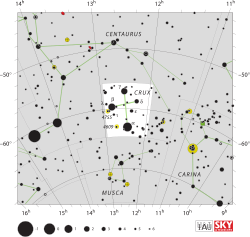Delta Crucis
| Observation data Epoch J2000 Equinox J2000 | |
|---|---|
| Constellation | Crux |
| Right ascension | 12h 15m 08.71673s[1] |
| Declination | −58° 44′ 56.1369″[1] |
| Apparent magnitude (V) | 2.78 - 2.84[2] |
| Characteristics | |
| Spectral type | B2 IV[3] |
| U−B color index | −0.921[4] |
| B−V color index | −0.235[4] |
| Variable type | β Cep[5] |
| Absolute magnitude (MV) | −3.2[7] |
| Details | |
Myr | |
| Database references | |
| SIMBAD | data |
Delta Crucis or δ Crucis, also identified as Imai (/ˈiːmaɪ/), is a star in the southern constellation of Crux, and is the faintest of the four bright stars that form the prominent asterism known as the Southern Cross. This star has an apparent magnitude of 2.8, and its proper name was adopted by the International Astronomical Union on 10 August 2018.[13] Imai is a massive, hot and rapidly rotating star that is in the process of evolving into a giant, and is located at a distance of about 345 light-years (106 parsecs) from the Sun.
Nomenclature
δ Crucis (Latinised to Delta Crucis) is the star's Bayer designation.
The International Astronomical Union Working Group on Star Names (WGSN)[14] approved the name Imai for this star on 10 August 2018 and it is in the list of IAU-approved star names.[13] Imai is the name selected for the star designated Delta Crucis by the Mursi people of modern-day Ethiopia. The star Imai has some significance as when it "ceases to appear in the evening sky at dusk (around the end of August), it is said that the Omo River rises high enough to flatten the imai grass that grows along its banks, and then subsides." The Mursi use a series of southern stars to mark their calendar to track seasonal flooding of the Omo River.[15]
It is sometimes called Pálida (Pale [one]) in Portuguese.[16]
Properties

This star has a
Delta Crucis is a member of the Lower Centaurus Crux (LCC) component of the
In culture
In
The
δ Cru is represented in the flags of
References
- ^ S2CID 18759600
- Bibcode:2009yCat....102025S.
- ^ Bibcode:1975mcts.book.....H
- ^ doi:10.1086/190168
- ^ hdl:2066/36162
- Bibcode:1999VeARI..35....1W
- ^ Bibcode:1989A&A...216...44D
- ^ S2CID 118629873
- Bibcode:1995A&AS..110..553S
- ^ Bibcode:1970CoAsi.239....1B.
- Centre de Données astronomiques de Strasbourg, retrieved 2005-11-05
- ^ a b "IAU Catalog of Star Names". International Astronomical Union. Retrieved 2018-09-17.
- ^ "IAU Working Group on Star Names (WGSN)". Retrieved 17 September 2018.
- ^ "IAU Working Group on Star Names (WGSN)" (Press release). IAU.org.
- ^ da Silva Oliveira, R., "Crux Australis: o Cruzeiro do Sul" Archived 2013-12-06 at the Wayback Machine, Artigos: Planetario Movel Inflavel AsterDomus.
- ^ "MAST: Barbara A. Mikulski Archive for Space Telescopes". Space Telescope Science Institute. Retrieved 8 December 2021.
- Commonwealth Scientific and Industrial Research Organisation, December 21, 2004, archived from the originalon 2012-03-18, retrieved 2012-01-16
- S2CID 17818058
- ISBN 978-986-7332-25-7.
- ^ (in Chinese) AEEA (Activities of Exhibition and Education in Astronomy) 天文教育資訊網 2006 年 7 月 29 日
- ISBN 978-0-521-36575-8.
- ^ "Astronomy of the Brazilian Flag". FOTW Flags Of The World website.

